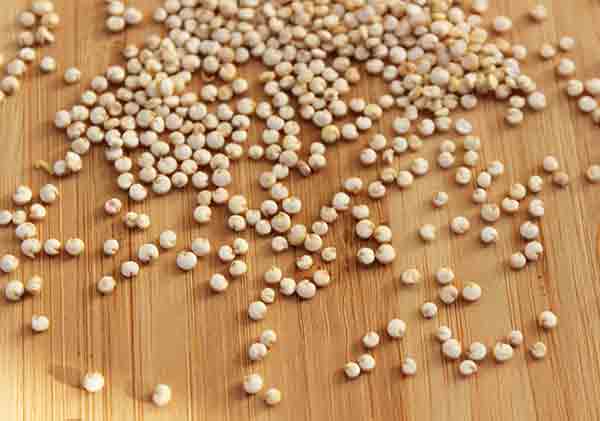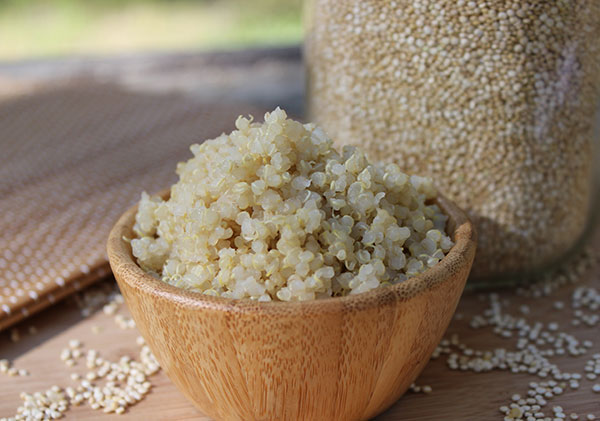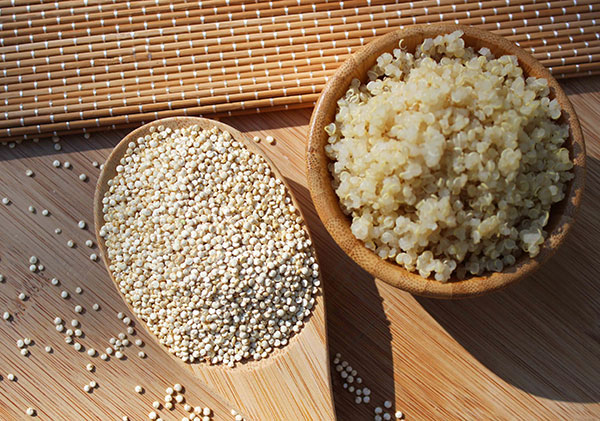Pronounced "keen-wah", it remained relatively unknown to the rest of the world until about the 1990's, when it was popularized to a significant degree by trending Western macrobiotic, vegetarian and vegan-based diets.
Author Donna Gates and her book "The Body Ecology Diet", first published in 1995, also played a significant role in introducing quinoa to many health seekers in California and other parts of the U.S.
Back then, it was chiefly found in local health food stores and only imported from 2-3 main South American producers. Today, quinoa is widely available at many large chain supermarkets from well over 50 different suppliers.
Becoming increasingly popular among a more mainstream audience for its higher protein to lower carbohydrate ratio, it has also taken center stage as one of the top gluten-free grains advocated for those with gluten intolerance, wheat allergies or celiac disease.
Although it is often referred to as "Incan rice", the Incan peoples actually adopted its dietary use and cultivation techniques from preceding Andean Quechua and Aymara cultures.
The Incas referred to quinoa as "chisaya mama" or "mother of all grains" and considered it a sacred food in which the first crops of the season were sown ceremonially with golden implements.
Quinoa, like the two other Incan grain varieties kañiwa and kiwicha (or amaranth), is known for its greater balance of essential amino acids compared to other grain types.
Becoming increasingly popular among a more mainstream audience for its higher protein to lower carbohydrate ratio, it has also taken center stage as one of the top gluten-free grains advocated for those with gluten intolerance, wheat allergies or celiac disease.
Although it is often referred to as "Incan rice", the Incan peoples actually adopted its dietary use and cultivation techniques from preceding Andean Quechua and Aymara cultures.
The Incas referred to quinoa as "chisaya mama" or "mother of all grains" and considered it a sacred food in which the first crops of the season were sown ceremonially with golden implements.
Quinoa, like the two other Incan grain varieties kañiwa and kiwicha (or amaranth), is known for its greater balance of essential amino acids compared to other grain types.
What is Quinoa?
Although it is considered a whole grain, quinoa is often called a "pseudocereal" because, unlike other cereal grains, it is actually a seed that comes from a non-grass species.
It belongs to the family Amaranthaceae (or goosefoot family) which includes other plants like lamb's quarters, beetroot, chard and spinach. It is also closely related to the mentioned kañiwa seed (Chenopodium pallidicaule) and many of the amaranth or Amaranthus species.
Wild variations of Chenopodium quinoa are native to the Andean region of South America and have been identified to have originated near Lake Titicaca bordering Peru and Bolivia, an area that was once home to the Incan peoples. The word "quinoa" in fact is derived from the common ancestral Andean Quechua language and the terms "kinwa" or "kinuwa."
According to the Lost Crops of the Incas, "Quinoa can be grown under particularly unfavorable conditions, at high elevation, on poorly drained lands, in cold regions, and under drought." (*)
It is an annual flowering weed-like plant that grows approximately 3-7 ft (1–2 m) tall. The tiny seed grains are about 0.08 in (2 mm) in diameter and usually a cream off-white color.
Wild variations of Chenopodium quinoa are native to the Andean region of South America and have been identified to have originated near Lake Titicaca bordering Peru and Bolivia, an area that was once home to the Incan peoples. The word "quinoa" in fact is derived from the common ancestral Andean Quechua language and the terms "kinwa" or "kinuwa."
According to the Lost Crops of the Incas, "Quinoa can be grown under particularly unfavorable conditions, at high elevation, on poorly drained lands, in cold regions, and under drought." (*)
It is an annual flowering weed-like plant that grows approximately 3-7 ft (1–2 m) tall. The tiny seed grains are about 0.08 in (2 mm) in diameter and usually a cream off-white color.
Depending on the cultivar, the plant however can also produce different colored grains. The two most common variations sold in the marketplace are black and red quinoa. These are often blended with white grains and sold as a tri-colored variety.
Uncooked quinoa seed has a flat rounded shape and, when completely steamed in water, pop open to form tiny rounded grains with a white curled germ falling off of them and a comparable texture to that of couscous or bulgur wheat.
Quinoa has a slightly bitter taste but pleasant buttery rich pasta-like flavor because of its higher protein content. Bitterness can be reduced by pre-rinsing the grains before cooking them and/or soaking them for a brief amount of time.
Cultivated red and black selections, have a rather different taste, a slightly denser quality and more fiber content than white quinoa. These colored grains are mainly pigmented on the outside of the seed, but when cooked produce a cream-colored center and curled germ.
Like wild lamb's quarter, the leaf of the quinoa plant (called "llipcha" in the Quechua language) is also edible and traditionally cooked like spinach, but can also been consumed as a raw salad green.
Quinoa has a slightly bitter taste but pleasant buttery rich pasta-like flavor because of its higher protein content. Bitterness can be reduced by pre-rinsing the grains before cooking them and/or soaking them for a brief amount of time.
Cultivated red and black selections, have a rather different taste, a slightly denser quality and more fiber content than white quinoa. These colored grains are mainly pigmented on the outside of the seed, but when cooked produce a cream-colored center and curled germ.
Like wild lamb's quarter, the leaf of the quinoa plant (called "llipcha" in the Quechua language) is also edible and traditionally cooked like spinach, but can also been consumed as a raw salad green.
Quinoa Seed Saponins
Quinoa seeds are known to have a thick saponin coating around the seed hull which acts as a natural pesticide to defend it from birds and other predators.
While saponins in small amounts are health enhancing substances, called triterpene saponins, often found in herbs like gynostemma and various other superfoods, when consumed in large quantities they can be potential "antinutrients."
This is due to their soap-like qualities which may cause mild gastrointestinal irritation and digestive upset. They also have a strong bitter-tasting flavor that is less palatable to some people.
Because saponins readily dissolve in water, rinsing the seeds before cooking them is a good way to remove most of the saponins encasing the seed.
Cultural Use of QuinoaThis can be achieved through either water washing or through a dry processing technique that usually involves a dehulling process. Both methods will invariably leave a small amount of saponin content, so it's a good idea to always briefly pre-rinse the grain before cooking.
Keep in mind, however, that in some research the saponins from quinoa were shown to have anti-inflammatory effects, so some remaining in your cooked grain can actually be beneficial, depending, of course, on one's digestive sensitivity level. (*)
Keep in mind, however, that in some research the saponins from quinoa were shown to have anti-inflammatory effects, so some remaining in your cooked grain can actually be beneficial, depending, of course, on one's digestive sensitivity level. (*)
Quinoa was one of the primary staple foods of the Andean peoples long before the Incan civilization.
In Andean locations, quinoa grain was traditionally steamed like rice and added to various dishes, soups and stews. It has also been used to make "chicha", a homemade fermented drink in regions near Lake Titicaca.
In Peru, the dry seeds are heated in a hot skillet and consumed as a type of mini-popcorn. Quinoa is also used straight or toasted and ground to make flour for use in various recipes and to fortify baked bread. In regions near Cusco and the Bolivian highlands, it is used to make "peske de quinoa" or "pesque", a spicy thick risotto-like dish.
In Andean locations, quinoa grain was traditionally steamed like rice and added to various dishes, soups and stews. It has also been used to make "chicha", a homemade fermented drink in regions near Lake Titicaca.
In Peru, the dry seeds are heated in a hot skillet and consumed as a type of mini-popcorn. Quinoa is also used straight or toasted and ground to make flour for use in various recipes and to fortify baked bread. In regions near Cusco and the Bolivian highlands, it is used to make "peske de quinoa" or "pesque", a spicy thick risotto-like dish.
Quinoa Domestication and Commercial Production
Archaeological evidence actually indicates that Andean quinoa was domesticated long before the Incan civilization.
In the book Quinoa: Sustainable Production, Variety Improvement, and Nutritive Value in Agroecological Systems, it was identified that pre-Incan native populations grew quinoa and also "practiced intensive agriculture, using irrigation, composting, rotations, and construction of terraces to conserve soil fertility in the mountains and to increase agricultural production, especially in the areas surrounding Lake Titicaca."
Over thousands of years, wild Chenopodium quinoa has been developed into many cultivated subspecies that are adaptable to a number of different climate zones and elevation ranges.
There are therefore many "landraces" or local crop varieties of quinoa seeds, especially between Cusco, Perú and Lake Poopó, Bolivia where it has long been domesticated, maintained and controlled by generations of Andean farmers.
Over thousands of years, wild Chenopodium quinoa has been developed into many cultivated subspecies that are adaptable to a number of different climate zones and elevation ranges.
There are therefore many "landraces" or local crop varieties of quinoa seeds, especially between Cusco, Perú and Lake Poopó, Bolivia where it has long been domesticated, maintained and controlled by generations of Andean farmers.
Certain Bolivian heirloom varieties, like "royal quinoa" or "royal pearl", are grown at higher elevations above 12,000 feet and believed to be superior in both taste and nutritional quality.
Why is Quinoa So Expensive?
Back in the late 90's, we remember purchasing a pound of organic quinoa for less than $1.50, a little more than most grains at that time. Then, over the next decade, it slowly increased to about $2.99 a pound which remained consistent for many years.
After 2013, the price soared considerably as popularity reached an all-time high. Currently as of 2017, bulk organic quinoa is usually sold at a price range between 5.99 and 8.99 in California and other U.S. locations. Pre-packaged whole grains are notably more expensive than purchasing it in bulk quantities.
Most economists believe the nearly tripled price of quinoa since 2006 is a classic example of supply and demand. The top South American producers, predominantly Bolivia and Peru, are simply not able to meet the demand which makes it more expensive. Price increases are also claimed to be necessary to provide a sustainable livelihood for many of these small-scale quinoa farming operations.
Crop expansion in other parts of the world is ongoing, but there have been some limitations apparently as far as seed distribution and sharing of quinoa germplasm as some farmers are understandably reluctant to share their unique seed cultivars.
Most economists believe the nearly tripled price of quinoa since 2006 is a classic example of supply and demand. The top South American producers, predominantly Bolivia and Peru, are simply not able to meet the demand which makes it more expensive. Price increases are also claimed to be necessary to provide a sustainable livelihood for many of these small-scale quinoa farming operations.
Crop expansion in other parts of the world is ongoing, but there have been some limitations apparently as far as seed distribution and sharing of quinoa germplasm as some farmers are understandably reluctant to share their unique seed cultivars.
In addition, we have found from our research that it is a crop that can be somewhat hard to introduce and establish successfully, especially in completely new terrains or among farmers used to growing other food staples.
According to the journal "Frontiers in Plant Science", the primary crop producers as of 2013 were Bolivia and Peru, who provided more than 80% of the global quinoa supply, with the remaining 20% coming from Ecuador, USA, China, Chile, Argentina, France and Canada. (Source)
Today the top producers are still Bolivia, Peru followed by Ecuador and the U.S, particularly California and Colorado.
Another reason for the added price increase, is also the now employed process of saponin removal which is necessary to improve the taste and digestibility of the cooked grain. (*)
According to the journal "Frontiers in Plant Science", the primary crop producers as of 2013 were Bolivia and Peru, who provided more than 80% of the global quinoa supply, with the remaining 20% coming from Ecuador, USA, China, Chile, Argentina, France and Canada. (Source)
Today the top producers are still Bolivia, Peru followed by Ecuador and the U.S, particularly California and Colorado.
Another reason for the added price increase, is also the now employed process of saponin removal which is necessary to improve the taste and digestibility of the cooked grain. (*)
Health Benefits of Quinoa
Higher in Protein and Essential Amino Acids
In research documented in the previously mentioned book Quinoa and the chapter entitled "Nutritional Properties of Quinoa", it was stated that "The protein content of quinoa ranges from 8% to 22% among different varieties." This variability is believed to be dependent on the specific genotype as well as the environment and climate in which it is grown.
About 60% of the protein content is found in the seed embryo, approximately 40% in the perisperm, and a small amount in the bran or outer seed coating and pericarp.
Along with teff, wild rice and amaranth, quinoa is a few grams higher in protein compared to other grain varieties. It also uniquely offers a higher protein to lower carbohydrate ratio as well as a balanced essential amino acid profile, providing a complete protein source.
About 60% of the protein content is found in the seed embryo, approximately 40% in the perisperm, and a small amount in the bran or outer seed coating and pericarp.
Along with teff, wild rice and amaranth, quinoa is a few grams higher in protein compared to other grain varieties. It also uniquely offers a higher protein to lower carbohydrate ratio as well as a balanced essential amino acid profile, providing a complete protein source.
Most grains are low in the essential amino acid lysine which helps the body to absorb calcium, build muscle, repair tissue and produce hormones.
One cup of cooked quinoa contains over twice the amount of lysine as the same proportion of brown rice (193mg lysine). The 442mg of lysine found in a 1C serving of quinoa is also substantially higher in contrast to white rice (153mg), millet (117mg), couscous (115mg) and about 153mg higher in lysine than buckwheat groats.
According to nutritional data, one cup of cooked quinoa contains 8 grams of protein content or 16% of the RDA, but again this could be potentially higher depending on the seed quality. (*)
Along with leafy green vegetables, spirulina and hemp seeds, quinoa is a choice plant-based protein-rich food to include in the diet whether vegan, vegetarian or seeking to reduce animal meat consumption.
While the concept that plant proteins are incomplete or inferior to "complete" animal-derived foods has been largely dismissed as false information by most holistic health nutritionists, when adhering to a vegan diet it is good to consume a varied combination of plant-based foods to ensure one's essential protein requirements are being met.
One cup of cooked quinoa (8g) contains about the protein equivalent of one large cooked egg (7g), one ounce of cooked skinned chicken breast (8g) and one ounce of salmon (7g).
Other grains also worthy of mentioning for their higher protein amounts include teff, amaranth and wild rice. Although most of these also have a greater ratio of carbohydrate content, they may also provide additional replacements to gluten-based selections.
According to nutritional data, one cup of cooked quinoa contains 8 grams of protein content or 16% of the RDA, but again this could be potentially higher depending on the seed quality. (*)
Along with leafy green vegetables, spirulina and hemp seeds, quinoa is a choice plant-based protein-rich food to include in the diet whether vegan, vegetarian or seeking to reduce animal meat consumption.
While the concept that plant proteins are incomplete or inferior to "complete" animal-derived foods has been largely dismissed as false information by most holistic health nutritionists, when adhering to a vegan diet it is good to consume a varied combination of plant-based foods to ensure one's essential protein requirements are being met.
One cup of cooked quinoa (8g) contains about the protein equivalent of one large cooked egg (7g), one ounce of cooked skinned chicken breast (8g) and one ounce of salmon (7g).
Other grains also worthy of mentioning for their higher protein amounts include teff, amaranth and wild rice. Although most of these also have a greater ratio of carbohydrate content, they may also provide additional replacements to gluten-based selections.
Leave your comment below.
Click Here For More Articles




No comments:
Post a Comment